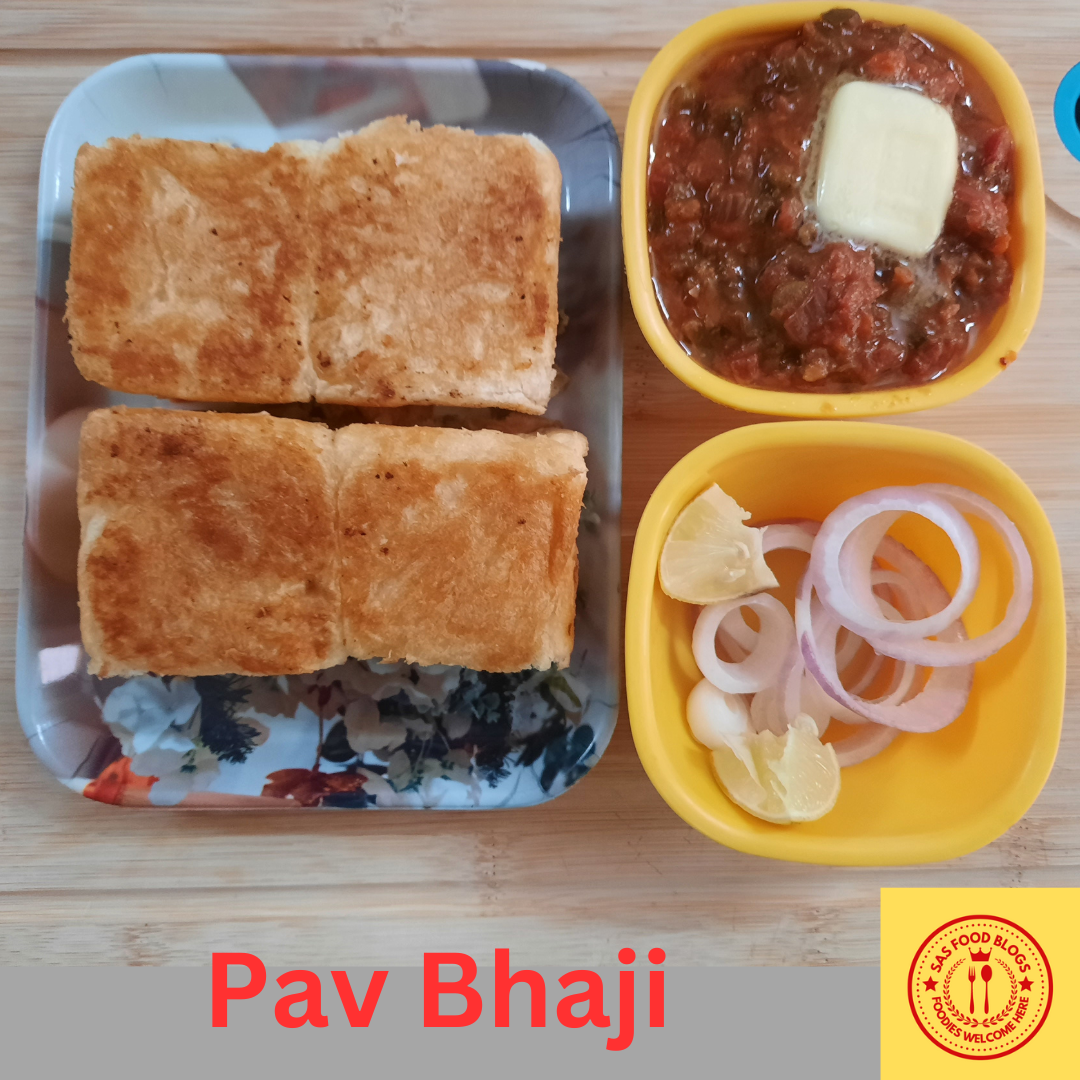How to make Pav Bhaji?
Hello Friends welcome to SAS FOOD BLOGS, Today we are going to see how to make Pav Bhaji.
It consists of a flavourful and spicy vegetable curry (bhaji) served with soft bread rolls (pav). It’s a delicious and satisfying snack or meal that is loved by people of all ages. Here’s a basic recipe for making Pav Bhaji:
INGREDIENTS:
For the Bhaji (Vegetable Curry):
- 2 cups mixed vegetables (e.g., potatoes, peas, carrots, bell peppers, cauliflower), chopped
- 2-3 medium-sized tomatoes, chopped
- 1 large onion, finely chopped
- Green chillies – 1 No finely chopped
- 1/2 cup cooked green peas
- 4 cloves garlic, minced
- 1-inch piece of ginger, minced
- 2 tablespoons oil or butter
- 2 teaspoons Pav Bhaji masala (a spice blend available in Indian grocery stores)
- 1/2 teaspoon red chili powder (adjust to taste)
- 1/2 teaspoon turmeric powder
- Salt to taste
- Fresh coriander leaves for garnish
- Lemon wedges for serving
For the Pav (Bread Rolls):
- 8-10 pav (small dinner rolls)
- Butter for toasting)
Preparation Method
Today’s recipe is delicious and taste recipe that is Pav Bhaji and so let’s gets started.
Step 1 (Pav Bhaji)
- Boil the mixed vegetables until they are soft and mashable. Drain and set aside.
- Take a pan and add oil or butter and then heat it medium flame add minced garlic, ginger, and green chillies. Sauté for a minute or until fragrant.
- Add chopped onions and sauté until they turn translucent.
- Then add the chopped tomatoes and cook until they become soft and start breaking down.
Step 2 (Pav Bhaji)
- Add the boiled vegetables and cooked green peas to the pan. Mix well and mash the vegetables with a masher or the back of a spoon.
- Add Pav Bhaji masala, red chilli powder, turmeric powder, and salt. Mix everything thoroughly.
- Cook the bhaji on medium heat for about 15-20 minutes, stirring occasionally. You may need to add a little water to achieve the desired consistency. The bhaji should be thick and well-cooked.
- While the bhaji is simmering, prepare the pav. Slice each pav horizontally, but not all the way through.
Step 3 (Pav Bhaji)
- Heat a griddle or tawa and add a little butter. Toast the pav on the griddle until they become crisp and golden brown on the inside.
- Serve the hot Pav Bhaji with a dollop of butter on top, garnished with chopped fresh coriander leaves and a lemon wedge on the side.
- Pav Bhaji is typically enjoyed with some finely chopped onions and additional lemon juice for added flavour. It’s a delightful and comforting street food dish that you can customize to suit your spice level and taste preferences.
Pav Bhaji is ready to serve, so you can try this recipe in your home and enjoy it and share the recipe with your family and friends.
Benefits of Kanda Bhaji:
Pav Bhaji is a popular Indian street food dish that is not only delicious but also offers some nutritional benefits when prepared with the right ingredients.
Step 4 (Pav Bhaji)
- Nutrient-Rich Vegetables: Pav Bhaji is primarily made from a variety of vegetables such as potatoes, peas, carrots, bell peppers, and cauliflower.
- These vegetables are rich in vitamins, minerals, and dietary fiber, making the dish a good source of essential nutrients.
- Fiber Content: The vegetables in Pav Bhaji provide dietary fiber, which can aid in digestion, promote a feeling of fullness, and help regulate blood sugar levels.
- Antioxidants: The tomatoes and other colourful vegetables in Pav Bhaji contain antioxidants like vitamin C and beta-carotene, which can help combat free radicals and reduce the risk of chronic diseases.
- Low in Fat: Depending on how it’s prepared, Pav Bhaji can be relatively low in fat, especially if you use minimal oil or butter. This makes it a healthier option compared to many other fried or oily street foods.
Step 5 (Pav Bhaji)
- Flavourful Spices: Pav Bhaji is seasoned with spices like turmeric, red chilli powder, and Pav Bhaji masala. These spices not only add flavour but may also offer potential health benefits
- Protein: While Pav Bhaji is primarily a vegetable-based dish, the addition of green peas and sometimes paneer (Indian cottage cheese) can provide a source of plant-based protein.
- Customizable: You can customize the spice level and ingredients in Pav Bhaji to suit your preferences and dietary requirements. For example, you can make it spicier or reduce the amount of butter or oil for a healthier version.
- It’s important to note that the nutritional value of Pav Bhaji can vary depending on the recipe and how it’s prepared.
- Some street vendors may use more butter or oil, which can increase the calorie and fat content.
- To make a healthier version at home, you can control the ingredients and cooking methods to align with your dietary goals.
- While Pav Bhaji can be a tasty and satisfying dish, it’s best enjoyed in moderation as part of a balanced diet, especially if you are conscious of your calorie intake or have specific dietary restrictions.
